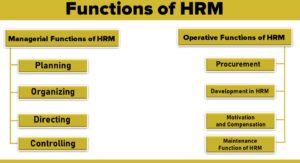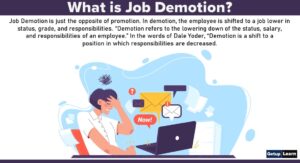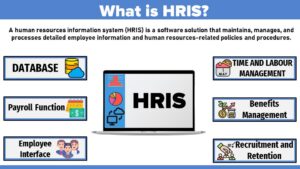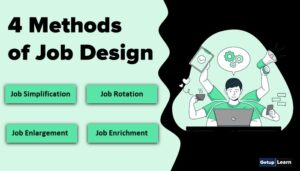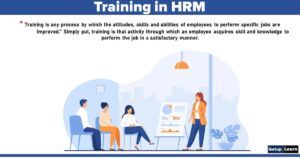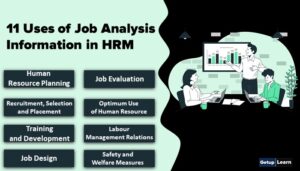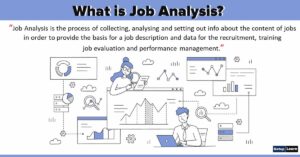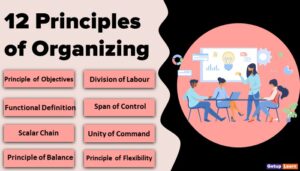Table of Contents
- 1 What is Human Resource Management?
- 2 Definition of Human Resource Management
- 3 Difference Between Personnel Management and HRM
- 4 Objectives of Human Resource Management
- 5 Features of Human Resource Management
- 6 Functions of Human Resource Management
- 7 Process of Human Resource Management
-
8 Importance of Human Resource Management
- 8.1 Future Personnel Needs
- 8.2 Part of Strategic Planning
- 8.3 Creating Highly Talented Personnel
- 8.4 International Strategies
- 8.5 Foundation for Personnel Functions
- 8.6 Increasing Investments in Human Resources
- 8.7 Resistance to Change
- 8.8 Uniting the Viewpoint of Line and Staff Managers
- 8.9 Succession Planning
- 8.10 Other Benefits
- 9 FAQ Related to Human Resource Management
What is Human Resource Management?
Human Resource Management is the planning organizing, directing, and controlling of the procurement, developments, compensation, integration and maintenance, and separation of human resources to the end that individual, organizational and societal objectives are accomplished.
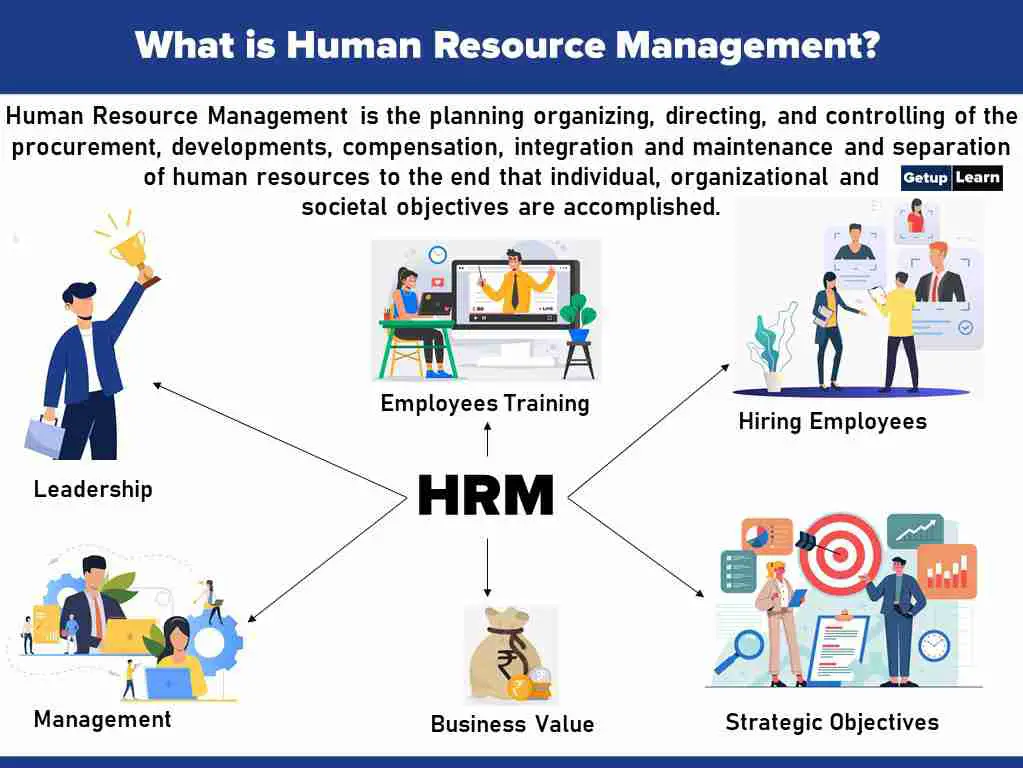
Human resources management is a management function concerned with hiring, motivating, and maintaining people in an organization. It focuses on people in organizations. Human resource management is designing management systems to ensure that human talent is used efficiently and effectively to accomplish organizational goals.
Human Resource Management can be defined as that field of management that has to do with planning, organizing, and controlling the functions of procuring, developing, maintaining, and utilizing a labor force such that:
- Objectives for which the company is established are attained economically and effectively.
- Objectives of all levels of personnel are served to the highest possible degree.
- Objectives of the society are duly considered and served.
The process of human resources management is the systematic planning, development, and control of a network of interrelated processes affecting and involving all members of the organization. These processes include:
- Human Resources Planning
- Job and Work Design
- Staffing
- Training and Development
- Performance Appraisal and Review
- Compensation and Reward
- Employee Protection and Representation
- Organization Improvement
Download: Human Resource Management Notes PDF
Definition of Human Resource Management
These are the definition of human resource management given below:
[su_quote cite=”Dale Yoder”]Human Resource Management as, “The planning, organizing, directing and controlling of procurement, development, compensation, integration, maintenance, and separation of human resources to the end that individual, organizational and social objectives are accomplished.”[/su_quote]
[su_quote cite=”George Terry”]Human Resource Management (HRM) is a series of integrated decisions that form the employment relationship; their quality contributes to the ability of the organizations and the employees to achieve their objectives.”[/su_quote]
[su_quote cite=”Edwin Flippo”]Human Resource Management (HRM) as “planning, organizing, directing, controlling of procurement, development, compensation, integration, maintenance, and separation of human resources to the end that individual, organizational and social objectives are achieved.[/su_quote]
[su_quote cite=”The National Institute of Personnel Management (NIPM)”]Human Resource Management (HRM) has defined human resources – personal management as “that part of management which is concerned with people at work and with their relationship within an enterprise. Its aim is to bring together and develop into an effective organization of the men and women who make up enterprise and having regard for the well–being of the individuals and of working groups, to enable them to make their best contribution to its success”.[/su_quote]
[su_quote cite=”Thomas G. Spates”]Human Resource Management (HRM) is a code of the ways of organizing and treating individuals at work so that they will get the greatest possible realization of their intrinsic abilities, thus attaining maximum efficiency for themselves and their group and thereby giving to the enterprise of which they are a part its determining competitive advantage and its optimum results.[/su_quote]
Difference Between Personnel Management and HRM
Following are points of difference between personnel management and hrm explained below:
| Point of Difference | Personnel Management | Human Resource Management |
| 1. Nature | Personnel management is concerned with ensuring that the current labor-management relationship is peaceful. So, it is reactive in nature. | Human Resource Management is concerned with the present conditions of the organization as well as it tries to foresee the future necessities so that appropriate actions can be taken in the present. So, it is proactive in nature. |
| 2. Focus | The focus of the activities of Personnel Management is on activities such as hiring, training, compensating, and maintenance of the existing workforce in the organization. So, it can be said that the activities of Personnel Management are employee-centric. | On the other hand, the activities of Human Resource Management are more focused on managerial aspects for delegating the responsibility of the HR Manager to the line authority for management development. So, it can be said that the activities of HRM are resource-centric. |
| 3. Relationship between Employee and Management |
Strict emphasis is placed on the observance of defined rules, procedures, and contracts that govern the relationship between the workforce and management in Personnel Management. | In the case of HRM, open-ended contracts are preferred so that they could be altered as per the needs of the business. The management accepts the responsibility to motivate and inspire the employees to improve their performance. |
| 4. Basic Premise | Personnel management considers that if the employees have job satisfaction then they would be able to perform in a better manner. It considers job satisfaction and morale as a source of better performance. | The basic premise of Human Resource Management is that job satisfaction and morale is something that occurs when the employee performs in a better manner. |
| 5. Type of Activity | Personnel management is a regular administrative function. The rewards received by employees are similar and are based on job evaluation as well as the worth of the job. | Human Resource Management tries to develop the competencies of the employees on a sustainable basis. The main characteristics of Human Resource Management include the formation and development of skills in the employees of the organization. |
| 6. Emphasis | The emphasis of Personnel Management is on monetary rewards and traditional job designs such as job simplification and job rotation so that people can be encouraged to improve their performance. | The emphasis of Human Resource Management is on autonomous workgroups and designing challenging and creative jobs so that people can be motivated. |
Objectives of Human Resource Management
Now let’s discussed some important objectives of human resource management. The objectives of Human Resource Management can be divided into two categories which are as under:

Societal Objectives
The societal objectives of Human Resource Management make the organization ethically and socially responsible for the needs and challenges of society and reduce the negative impact of such demands on the organization. This is very essential as, if an organization does not use the resources of the society in an ethical manner, the society may restrict the smooth functioning of the organization.
So, Human Resource Management provides a way in which the resources of the society are used by the organization in such a manner that is beneficial to both the society and the organization.
Organizational Objectives
The organizational objectives of Human Resource Management recognize that it is a means to assist the organization in achieving its objectives. It recognizes that the function of Human Resource Management is to increase the effectiveness of the organization by searching and providing the right type of employee for a job in an organization which contributes towards the achievement of the objectives of the organization.
So, the Human Resources Department is out there to provide services to all the other departments of the organization.
Functional Objectives
The functional objectives of Human Resource Management establish the role of the Human Resources Department in maintaining the appropriate level of contribution that it can make towards the organization. The need for Human Resources is formulated according to the demand of the organization.
There is a wastage of resources if the Human Resources Department is more or less sophisticated. The level of services provided by the Human Resources Department should be altered as per the needs of the organization.
Personal Objectives
The personal objectives of Human Resource Management facilitate that employees in achieving their personal goals. The personal objectives of the workers should be preserved, maintained, and nurtured. This will ensure that the employees remain satisfied and this would reduce employee turnover.
Failure to do so, employee satisfaction will reduce which might affect their performance which in turn might increase employee turnover.
Some Specific Objectives of Human Resource Management
- To help the organization to achieve its objectives.
- To employ the skills and ability of employees in such a manner to benefit customers, stockholders, and employees.
- To stimulate and motivate employees to maximize their efforts so that their satisfaction level increases.
- To improve the quality of work-life of employees so that their productivity improves.
- To manage Human Resources in an ethical and socially responsible manner by ensuring that all legal provisions are complied with.
Features of Human Resource Management
Human Resource Management is a strategic approach of the management towards the people working in the organization whose individual as well as group efforts are directed towards the achievement of the objectives of the business. The following are the features of Human Resource Management that could be identified:
- People Oriented
- Individual Oriented
- Continuous Function
- Pervasive Function
- Challenging Function
- Based on Human Relations
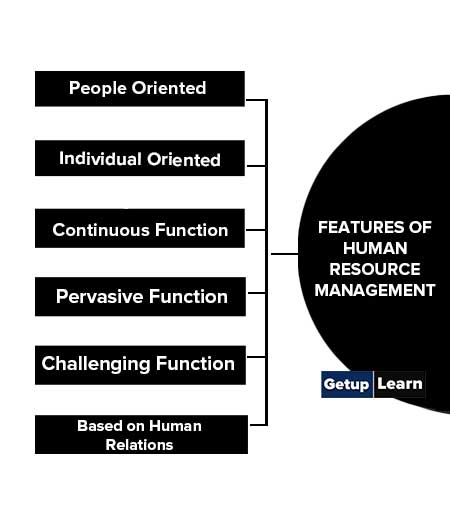
People Oriented
Human Resource Management is concerned with employees as both individuals and groups who are working towards achieving the goals of the organization. It is concerned with the improvement of the Quality of Work Life of employees working at all levels of the organization.
Individual Oriented
Human Resource Management is concerned with the development of each and every employee working in the organization by developing their skills, knowledge, capabilities, and potentialities which help in training the goals of the employees as well as the objectives of the organization.
Continuous Function
Human Resource Management is a continuous and never-ending process. There is a constant need in the organization to improve the skills of the employees and ensure that the employees are satisfied. Due to this, Human Resources Department has to work continuously in this regard.
Pervasive Function
The function of managing human resources has to be undertaken by all the managers in the organisation. The employees working under each manager have to be managed by that manager only and this task cannot be delegated to someone else be it the Managing Director of the company or a foreman supervising the workers in the factory.
Challenging Function
The management of human resources is a challenging activity due to the dynamic and unique nature of human resources. Human Resource Management aims at securing unreserved cooperation from all employees for attaining the goals of the organization.
Based on Human Relations
Human Resource Management is concerned with the motivation of human resources. For this, the needs, perceptions, and expectations of each and every individual worker have to be identified. Further, human relation skills also are also required in training, performance appraisal, transfer, and promotion of subordinates.
If human relations are maintained by the managers, the atmosphere in the organization would remain cordial and it would help the organization to attain the decided objectives without any hindrances.
Functions of Human Resource Management
The functions of Human Resource Manager can be divided into three categories. Let us understand each one in detail:
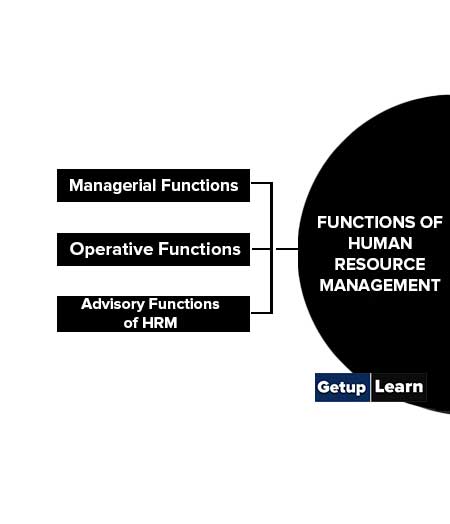
Managerial Functions
A human Resource Manager like any other manager also performs basic managerial functions such as planning, organizing, directing, and controlling in the context of his own department. The following are the various activities undertaken by the Human Resource Manager in his capacity as a manager of a department.
Planning
In order to get things done, like any manager, Human Resource Manager also plans for completing tasks that are assigned to him. The Human Resource Manager determines in advance, aspects that might arise which are related to personnel of the organization.
The Human Resource Manager anticipated the vacancies which might arise and plans for fulfilling these vacancies as well as prepares the descriptions for these jobs and finds out the sources from where the employees for these posts may be recruited.
For undertaking all of these activities, supply and demand in the labor market have to be forecasted. Then the shortage or excess of the personnel for these jobs for a specific period has to be determined and after that plans for restoring balance for the same have to be formulated by the Human Resource Manager.
Organizing
When the objectives are established and the plans are developed, the Human Resource Manager has to design and develop an organizational structure to undertake various operations. In order to develop an organisational structure, the Human Resource Manager has to consider the following aspects:
- The activities should be arranged and grouped as per functions or positions in a logical manner.
- Different groups or activities are grouped into different individuals.
- Delegation of authority and responsibility which is required has to be undertaken.
- Coordination between various activities which are to be performed has to be created.
Direction
After the plans are put into effect, the Human Resource Manager has to motivate the people in the organization for implementing them in an effective manner. By doing so, the Human Resource Manager tries to encourage the people in the direction which helps in the accomplishment of the objectives of the organization.
The Human Resource Manager has to motivate employees by undertaking career planning, fixing proper salaries, and ensuring that the morale of the employees is maintained. The Human Resource Manager also ensures that the relations between the employees of the organization are cordial and ensure that the necessary safety and welfare measures are taken for the employees.
He further, has to identify the needs and wants of the employees and ways in which they can be satisfied so that he is able to motivate them in an appropriate manner. One of the challenges that a Human Resource Manager faces is that motivation is a continuous process and when old needs are satisfied new needs arise and the manager has to find ways in order to satisfy those new needs. So the Human Resource Manager has to determine the current needs of the employees.
Controlling
The Human Resource Manager has to undertake a controlling activity for regulating the activities and ensuring that all the activities are performed according to the plans which are formulated. This activity completes the cycle and leads back to the planning phase. The manager compares the activities performed with the standards which are set and tries to identify the deviations which might have occurred. For this, a critical evaluation of personnel records is undertaken by him through Human Resources Audit.
Operative Functions
The operative functions of the Human Resources Department include the specific functions which are performed by the Human Resource Manager. These functions include:
Employment
Under the employment function, the Human Resource Manager has to acquire the right kind of person for the job in the required number which is necessary for attaining the objectives of the organization. This includes the activities of recruitment, selection, placement, and related activities.
Before the performance of these activities, the actual manpower requirement is determined and a detailed profile of the jobs is prepared. The sources of the manpower supply are determined and then the necessary induction and training programs are designed to enable the employees to perform their work in the best possible manner.
Development
Once the necessary number of employees are acquired, then the follow-up activity of training and development is undertaken. The Human Resource Manager has a duty to train each and every employee of the organization in the best possible manner.
He has to ensure that the employee acquires the essential technical skills which are required for undertaking his job. He should also ensure that there is the proper development of skills in the employees by designing the appropriate training programs.
For this, a proper mix of on-the-job as well as off-the-job training methods is required. The old, as well as new employees, should be made to participate in these programs for the enhancement of their knowledge as well as the development of their skills.
Compensation
The Human Resource Manager has to determine the adequate and reputable remuneration for the employees of the organization. Such remuneration can be in form of monetary or non-monetary compensation.
Factors such as the basic needs of the employees, job requirements, legal provisions, the organization’s capacity, and the level of remuneration paid by competitors should be kept in mind before deciding the amount of compensation. The fixation of wages is done by undertaking job evaluation and performance appraisal.
Maintenance
The Human Resource Manager is also responsible to ensure that the employees are satisfied with their working conditions. They should take necessary measures for maintaining the safety, health, and welfare of the employees.
Moreover, the Human Resource Manager should ensure that facilities such as cafeteria, restrooms, group insurance, and other welfare services are provided to the employees so that their motivation level is maintained.
Motivation
The level of motivation ensures that the employees remain loyal to the organization. For this, the Human Resource Manager has to constantly identify the needs of the employees and find out ways to fulfill them. in order to motivate the employees, the Human Resource Manager along with other managers should design a system of rewards that comprise the financial as well as non-financial components.
Personnel Records
The Human Resources Department has a responsibility to maintain a detailed record of each and every employee regarding their achievements, various positions held by them, their transfers, and promotions. They also have to keep a record of their work and leaves taken them as well as a number of training programs in which they have participated.
Industrial Relations
The Human Resource Manager is also responsible to act as a negotiator between the workers and the organization in case any dispute arises. They also ensure that such disputes may not arise by ensuring that the workers remain satisfied and the work environment is comfortable. He is also responsible for ensuring that appropriate safety and welfare measures are undertaken.
Further, he also has to design an effective grievance redressal system for the problems and issues that are faced by the workers. He also acts as a link between the top management and the labor unions by presenting the view of each party to the other without any bias.
Advisory Functions of HRM
As Human Resource Manager is an expert in the area of managing human resources, in aspects which are related to Human Resources, he gives his advice to the top management as well as all the departmental heads. The human Resource Manager advises the top management regarding the formulation and evaluation of the human resource programs, policies, and procedures.
He also advises the top management regarding how the morale of the employees can be maintained. The Human Resource Manager also advises the departmental heads on aspects such as manpower planning, job analysis, and design, recruitment and selection, placement, training, and aspects of performance appraisal.
Process of Human Resource Management
The process of human resource management consists of four functions which include Acquisition of human resources, development of human resources, motivation of human resources, and maintenance of human resources. Let us understand each function in detail:
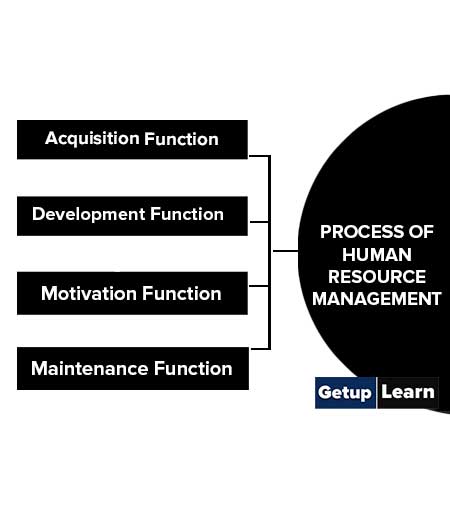
Acquisition Function
This is the first step of the Human Resource Process where the managers seek, secure and employ those people who have the necessary knowledge and skills which are necessary to achieve the objectives of the organization. The first stage of the acquisition function begins with planning.
This function covers other functions such as job analysis, Human Resource Planning, recruitment, selection, placement, induction, and ensuring internal mobility of employees in the organization.
Development Function
The Human Resource Manager by using the development function improves, molds, and develops the skills, knowledge, artistic ability, aptitude, and values of the employees. There are three dimensions of the development function:
Employee Training
The training of employees is a procedure of making the employees aware of the operating and technical skills that are required to perform the task that is assigned to them in the organization. It also includes changing the attitude that is prevalent among the employees.
Management Development
Management development is concerned with the acquisition of knowledge and enhancement of the abilities of the executives. Through this function, suitable programs are designed and developed and appropriate methods of their implementation are derived.
Career Development
With the help of career development, the management makes repeated ef- forts to match long-term individual needs with those of the organization. This helps the efficient development of human resources with up-to-date skills and knowledge.
Motivation Function
The beginning of the motor function takes place by recognizing that all the employees of the organization are unique and the techniques used for motivating each and every employee is different. Through the motivation function, the management tries to integrate people working in the same organization in such a manner that they are motivated to work together for achieving the objectives of the organization.
The management through this function seeks to establish economic, psychological, and social satisfaction.
Maintenance Function
Through the maintenance function, the management tries to provide a better working environment to the employees of the organization so that their satisfaction levels do not fall down and their commitment to the organization remains constant. This is done to retain the employees who are working in a satisfactory manner in the organization.
The maintenance function of Human Resource Management included the provision of safe and healthy working conditions in the organization along with satisfactory labor relations.
Importance of Human Resource Management
HRP is the subsystem in the total organizational planning. Organizational planning includes managerial activities that set the company’s objective for the future and determines the appropriate means for achieving those objectives. The importance of human resource management is elaborated on the basis of the key roles that it is playing in the organization:
- Future Personnel Needs
- Part of Strategic Planning
- Creating Highly Talented Personnel
- International Strategies
- Foundation for Personnel Functions
- Increasing Investments in Human Resources
- Resistance to Change
- Uniting the Viewpoint of Line and Staff Managers
- Succession Planning
- Other Benefits
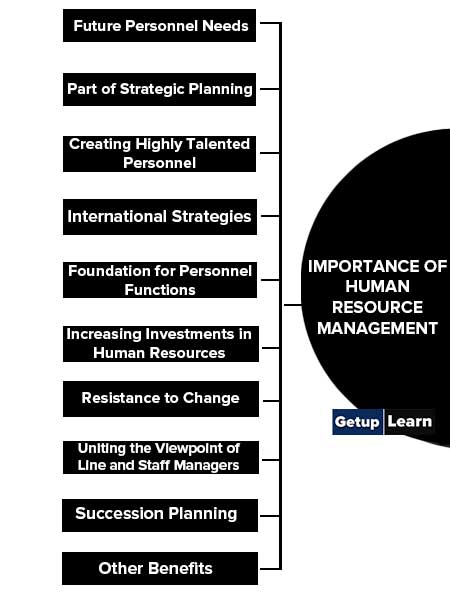
Future Personnel Needs
Human resource planning is significant because it helps to determine the future personnel needs of the organization. If an organization is facing the problem of either surplus or deficiency in staff strength, then it is the result of the absence of effective HR planning. All public sector enterprises find themselves overstaffed now as they never had any planning for personnel requirements and went on a recruitment spree till the late 1980s.
The problem of excess staff has become such a prominent problem that many private sector units are resorting to VRS’s‘ voluntary retirement scheme’. The excess of labor problem would have been there if the organization had a good HRP system. An effective HRP system will also enable the organization to have good succession planning.
Part of Strategic Planning
HRP has become an integral part of strategic planning. HRP provides inputs in the strategy formulation process in terms of deciding whether the organization has got the right kind of human resources to carry out the given strategy. HRP is also necessary during the implementation stage in the form of deciding to make resource allocation decisions related to organization structure, process, and human resources.
In some organizations, HRP plays a significant role as strategic planning and HR issues are perceived as inherent in business management.
Creating Highly Talented Personnel
Even though India has a great pool of educated unemployed, it is the discretion of the HR manager that will enable the company to recruit the right person with the right skills for the organization. Even the existing staff hope the job so frequently that organization faces a frequent shortage of manpower.
Manpower planning in the form of skill development is required to help the organization in dealing with this problem of skilled manpower shortage.
International Strategies
An international expansion strategy of an organization is facilitated to a great extent by HR planning. The HR department’s ability to fill key jobs with foreign nationals and reassignment of employees from within or across national borders is a major challenge that is being faced by international business. With the growing trend toward global operation, the need for HRP will as well be the need to integrate HRP more closely with the organization’s strategic plans.
Without effective HRP and subsequent attention to employee recruitment, selection, placement, development, and career planning, the growing competition for foreign executives may lead to expensive and strategically descriptive turnover among key decision-makers.
Foundation for Personnel Functions
HRP provides essential information for designing and implementing personnel functions, such as recruitment, selection, training and development, and personnel movements like transfers, promotions and layoffs.
Increasing Investments in Human Resources
Organizations are making increasing investments in human resource development compelling the increased need for HRP. Organizations are realizing that human assets can increase in value more than physical assets. An employee who gradually develops his/ her skills and abilities becomes a valuable asset to the organization.
Organizations can make investments in their personnel either through direct training or job assignment and the rupee value of such a trained, flexible, motivated productive workforce is difficult to determine. Top officials have started acknowledging that the quality of the workforce is responsible for both the short-term and long-term performance of the organization.
Resistance to Change
Employees are always reluctant whenever they hear about change and even about job rotation. Organizations cannot shift one employee from one department to another without any specific planning. Even for carrying out job rotation (shifting one employee from one department to another), there is a need to plan well ahead and match the skills required and existing skills of the employees.
Uniting the Viewpoint of Line and Staff Managers
HRP helps to unite the viewpoints of line and staff managers. Though HRP is initiated and executed by the corporate staff, it requires the input and cooperation of all managers within an organization. Each department manager knows about the issues faced by his department more than anyone else. So communication between HR staff and line managers is essential for the success of HR Planning and development.
Succession Planning
Human Resource Planning prepares people for future challenges. The ‘stars’ are picked up, trained, assessed and assisted continuously so that when the time comes such trained employees can quickly take the responsibilities and position of their boss or seniors as and when the situation arrives.
Other Benefits
- HRP helps in judging the effectiveness of manpower policies and programs of management.
- It develops awareness of the effective utilization of human resources for the overall development of the organization.
- It facilitates the selection and training of employees with adequate knowledge, experience, and aptitudes so as to carry on and achieve the organizational objectives.
- HRP encourages the company to review and modify its human resource policies and practices and to examine the way of utilizing the human resources for better utilization.
What is Human Resource Management Meaning?
Human Resource Management refers to managing the organization’s workforce in an effective and efficient manner. Human Resource Management aims at attracting, managing, and maintaining human resources in an effective and efficient manner.
What are the definitions of human resource management?
Edwin Flippo defines as HRM planning, organizing, directing, controlling procurement, development, compensation, integration, maintenance, and separation of human resources to the end that individual, organizational and social objectives are achieved.
What are the objectives of human resource management?
These 8 primary objectives of human resource management are (1) Achieve organizational goals, (2) Work culture, (3) Team integration, (4) Training and Development, (5) Employee motivation, (6) Workforce empowerment, (7) Retention, (8) Data and compliance, etc.
What are HRP and its features?
These are some important features of human resource management: 1 People Oriented, 2 Individual Oriented, 3 Continuous Function, 4 Pervasive Function, 5 Challenging Function, 6 Based on Human Relations, etc.
What are the 3 major HR functions?
These are 3 major functions of human resource management: (1) Managerial Functions, (2) Operative Functions, and (3) Advisory Functions of HRM.

